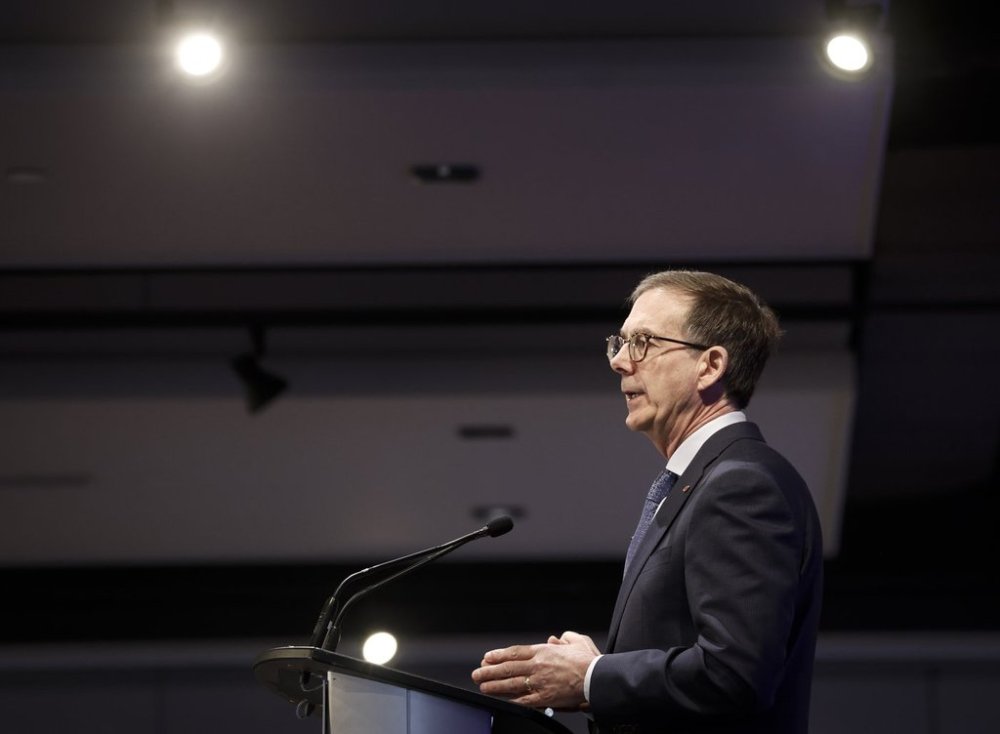Diversifying trade key to building resilience against U.S. tariffs: Macklem
Advertisement
Read this article for free:
or
Already have an account? Log in here »
To continue reading, please subscribe:
Monthly Digital Subscription
$1 per week for 24 weeks*
- Enjoy unlimited reading on winnipegfreepress.com
- Read the E-Edition, our digital replica newspaper
- Access News Break, our award-winning app
- Play interactive puzzles
*Billed as $4.00 plus GST every four weeks. After 24 weeks, price increases to the regular rate of $19.00 plus GST every four weeks. Offer available to new and qualified returning subscribers only. Cancel any time.
Monthly Digital Subscription
$4.75/week*
- Enjoy unlimited reading on winnipegfreepress.com
- Read the E-Edition, our digital replica newspaper
- Access News Break, our award-winning app
- Play interactive puzzles
*Billed as $19 plus GST every four weeks. Cancel any time.
To continue reading, please subscribe:
Add Free Press access to your Brandon Sun subscription for only an additional
$1 for the first 4 weeks*
*Your next subscription payment will increase by $1.00 and you will be charged $16.99 plus GST for four weeks. After four weeks, your payment will increase to $23.99 plus GST every four weeks.
Read unlimited articles for free today:
or
Already have an account? Log in here »
OTTAWA – Bank of Canada governor Tiff Macklem is encouraging businesses to explore export markets beyond the United States to make the economy less vulnerable to current and future trade disputes.
Speaking to a business crowd in coastal St. John’s, N.L., on Wednesday, Macklem meanwhile warned of fog in the inflation forecast, making it difficult to chart a path for monetary policy through the tariff uncertainty.
The central bank head said it was “very welcome news” that Prime Minister Mark Carney and U.S. President Donald Trump agreed at the G7 Summit earlier this week to nail down a new trade and security deal within 30 days.

He said in prepared remarks that progress toward a new trade deal is “encouraging,” but later said in a moderated question-and-answer period that Canada’s economy faces bigger problems in an increasingly “fragmented world.”
Trade patterns were already shifting before Trump was re-elected late last year, Macklem noted, and other global conflicts are also forcing businesses to reorient supply chains.
“I really hope we get a deal, I really hope it’s a good deal, but that’s not going to solve all our problems,” he said.
Disruptions during COVID-19 showed Canadian firms the consequences of not having diverse supply chains, Macklem said. And he said the current trade dispute is demonstrating how vulnerable businesses can be without diverse export markets.
“Growing new markets for our exports builds scale and competitiveness. But there’s an added imperative — diversification adds resilience,” he said in his speech.
Macklem used Newfoundland and Labrador as a case study for his point, noting that only a third of the province’s goods exports head to the United States compared with roughly three-quarters for the rest of Canada. Most of the province’s oil is now shipped to Europe and other countries, for instance, and services exports are boosting the St. John’s tech sector, he noted.
Macklem said the rest of Canada has an opportunity, particularly among services exports, to expand trade beyond the United States. Efforts to build national infrastructure and tear down interprovincial trade barriers would also make diversifying goods exports easier, he said.
The United States will always be Canada’s biggest trading partner, Macklem said, but he believes the recent tariff dispute has awoken businesses and policymakers to long-standing vulnerabilities in the economy by being so focused on cross-border trade.
“This is something we’ve been talking about for a long time in this country,” he said during the Q&A.
“The reality is, we’re just leaving money on the table by not building our own internal market, by not developing our overseas markets.”
The Bank of Canada held its benchmark interest rate steady at 2.75 per cent for the second time in a row earlier this month.
The central bank’s next decision is set for July 30, and Macklem reiterated that future cuts could be in the cards if economic growth weakens further but inflation remains contained in the trade dispute.
While labour market impacts are largely concentrated in trade-sensitive sectors so far and other industries are still showing some growth, Macklem said that, “if demand stays soft, at some point more businesses will cut jobs.”
Tracking inflation’s response to tariffs is “complicated,” the central bank head noted. A slower economy dampens price pressures but the tariffs themselves can make goods more expensive for Canadians.
While the removal of the consumer carbon price helped push inflation down to 1.7 per cent in April, Macklem cautioned that’s only short-term relief for the annual comparisons.
Inflation excluding taxes was 2.3 per cent in the month, which he said was “slightly stronger” than the Bank of Canada expected.
He said that certain core measures of inflation are now running above three per cent and “could be firmer” than the central bank first thought.
But Macklem also warned there’s “potentially some distortion” in the Bank of Canada’s preferred core inflation figures that could be “exaggerating” price pressures.
Alternative measures of core inflation are coming in lower, so he said the central bank is looking at a range of factors as it gauges where inflation is heading next.
Macklem pointed to higher goods prices affecting the underlying inflation figures, which could be starting to reflect new costs related to tariffs.
“The bottom line, as I indicated, is we have seen more firmness in underlying inflation, and that’s something that’s got our attention,” he said in the press conference.
“There is some unusual volatility. So how temporary or persistent this is, I think remains an open question.”
The Bank of Canada will get two inflation readings before its next interest rate decision, with Statistics Canada set to report May inflation figures on June 24.
This report by The Canadian Press was first published June 18, 2025.

